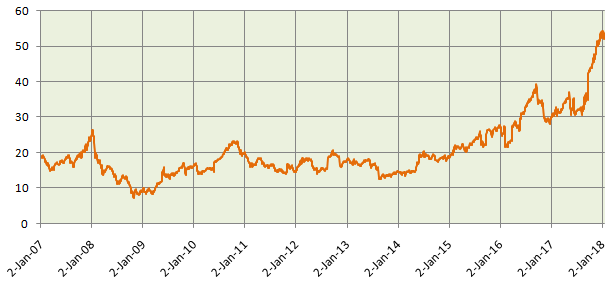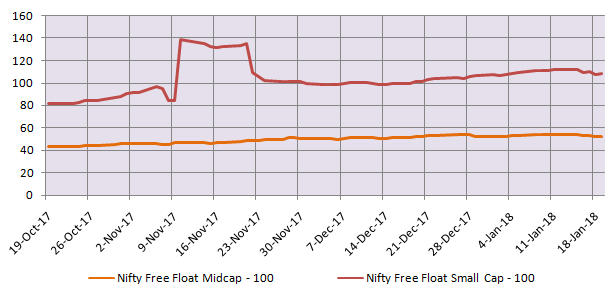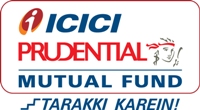Are midcap valuations a cause of concern: Part 2

In our last post, Are midcap valuations a cause of concern – Part 1, we discussed some of the concerns related to midcap valuations. Most of the discussion in Part 1 was centered on and around relative valuations of large cap and midcap (and small cap) stocks. Though large cap stocks traditionally enjoyed a valuation premium over midcap stocks, the situation has now reversed and large cap stocks are trading at a discount to midcap stocks.
Reading the difference between investing in large cap and mid cap funds may help you
In Part 1, we also challenged the conventional wisdom with regards to midcap valuations premiums. Midcap companies with less capital intensive business, lower debt levels, nimble business models and operating in niche spaces can deliver faster earnings growth than large cap and therefore, may justify their higher valuations. In this post, we will discuss that, higher earnings growth potential notwithstanding, whether the midcap valuation premium at the current level too high?
Midcap valuations have not yet approaching bubble zone
Some experts are concerned that valuation of midcap and small stocks are approaching asset bubble zone; asset bubbles indicate that a crash is imminent. The Nifty Free Float Midcap – 100 index PE multiple is at its all time (around 52 times earnings). Based on historical precedence of asset bubbles, PE multiples of 50 to 55 are not yet in the bubble zone. During the dotcom bubble in 2000, PE multiples of some technology companies were in excess of 75 times earnings, some approaching or even exceeding 100. Nifty Free Float Midcap – 100 Index is some distance away from that zone. Therefore, midcap fund investors need not panic and sell.
But midcap valuations are well above historical averages
The long term historical average PE multiple of the Nifty Free Float Midcap – 100 index is around 18. Currently the PE multiple of the midcap index it is around 52. Clearly, the current valuation of the midcap index is almost three times of the long term historical average. Midcap funds have given fantastic returns over the last 4 to 5 years, but purely from a valuation time series perspective, PE multiple of Nifty Free Float Midcap – 100 index is clearly a cause of concern.

Source: National Stock Exchange
Valuation (P/E) versus EPS growth in the Indian market context
In our previous post, Are midcap valuations a cause of concern – Part 1, we discussed that high valuations can be justified by high earnings (EPS) growth. Historically, PE multiples of 20 – 22 times were supported by consistent 25% EPS growth. Going by the historical correlation between PE multiple and EPS growth, extraordinarily high earnings growth would be required to justify a PE multiple of 50+. To put this in perspective for benefit of our readers, Nifty and CNX – 500 EPS growth in Q2 FY 2018 was in single digits. So, we are looking for something extraordinary if PE multiples of 50+ are to be justified.
Some of our readers may ask why the market is so high and rising (valuations getting richer) despite low earnings growth which has been low for the past few years. The answer is liquidity – both in terms of global flows and domestic flows to the stock market. The India Growth Story enabled by Government reforms has strong appeal for both foreign and domestic investors. Liquidity may continue to support high valuations for midcap stocks for some more time, but further price upside may be limited unless they are supported by earnings growth.
The problem with liquidity fueled high valuations, not supported by earnings growth, is that when sentiments change course, the price correction can be quite brutal. Let us understand the problem of high valuation and low earnings growth with the help of an example.
Suppose a stock is trading at a price of Rs 100. The EPS of the stock is Rs 2. So the current PE multiple of the stock is 50. Let us assume that in the optimistic scenario the EPS will grow at 25% per annum. Let us further assume that the long term average PE multiple of the stock is 25. There is sufficient liquidity (but not irrational bullishness) in the market, which will support the share price, albeit at a slower growth rate, so that the PE multiple can revert back to its long term average on the back of strong EPS growth. The table below shows the share price, EPS and PE projections.

You can see that, even in Year 5 the PE multiple is above the long term average. All this while, the investor has to contend himself with just 10% annualized returns. In year 6, the PE multiple is below its long term average and if EPS growth continues to remain strong, then the investor will start to get good returns from Year 6 onwards.
Let us now discuss the risk implicit in this example. We made an assumption that liquidity will support the share price, but our experience in the stock market over the last 20 years tells us that, investment cycles are rarely 5 to 6 years long. Risk sentiments can worsen due to a variety of global factors. Then money flows out of stock market into less risky asset classes like Government bonds and share prices correct. These corrections are particularly brutal for richly valued stocks. Suppose the correction comes in Year 4. The EPS in Year 3 is 3.9. Based on the long term average valuation, the share price should be Rs 3.9 X 25 = Rs 97. The market correction is likely to take the share price below Rs 97 from Rs 133; a loss of at least 27%. If the correction comes earlier, say in year 3, the share price may fall to Rs 78 (Rs 3.1 X 25) or below from Rs 121; a loss of at least 35%. When investors make a big loss in the stock market, they often blame their luck or their broker, but very often it is the investor’s greed to blame.
If a stock has risen 100% or more in the last 2 or 3 years, you cannot expect the same rate of growth to be sustained in the future. Top performing small and midcap equity mutual funds on average gave more than 20% annualized returns in the last 3 years and more than 35% returns in the last one year. One cannot expect these returns to be sustained in the future; in fact, a price correction at some point of time in the near to medium term should be the likely scenario because of the reasons we have discussed in this blog post.
Midcap versus Small Cap
In Advisorkhoj, we do not distinguish between midcap and small cap equity mutual funds from a categorization standpoint because many midcap mutual funds invest in small cap stocks also. However, some small and midcap funds have a large percentage of their portfolio holdings in small cap stocks. National Stock Exchange (NSE) and Bombay Stock Exchange (BSE) have separate indices to track midcap and small cap share prices.
As discussed earlier, the PE multiple of Nifty Free Float Midcap – 100 is around 52 times earnings.The PE multiple of Nifty Free Float Small Cap – 100 is more than 100 times earnings (108X as on January 19, 2018). This is very high valuation and investors should be extremely cautious about getting into stocks at these valuations because these valuations, based on historical evidence, seem to be in the bubble zone. The chart below shows the PE multiples of Nifty Free Float Small Cap – 100 versus Nifty Free Float Midcap – 100 over the last 4 months.

Source: National Stock Exchange
You can see that, the valuation spread between midcap and small cap stocks have widened slightly over the past 4 months. If you invested in small cap oriented equity mutual fund, you would have got fantastic returns but for near term to medium term returns in the future, you should be concerned about these valuations.
Importance of Asset Allocation
We have discussed the importance of asset allocation a number of times in our blog. Asset allocation ensures that you invest in the right asset class to meet your financial goals. It ensures that, you take the right amount of risk; too much or too little risk, can both harm your financial goals. One aspect of asset allocation often ignored by many retail investors in India is the importance of asset re-balancing.
You must read Asset allocation and market cycles
Based on my conversations with many investors, I have noticed that, most investors in India do not give any importance to asset allocation. Bank FDs and Post Office (Government) small savings schemes are the automatic savings options for most investors. When stock marketis rallying, some investors allocate a portion of their savings to equity, either by directly investing in stocks or through equity mutual funds.
Asset allocation, however, is extremely important in ensuring that, investors meet their short term, medium term and long term financial goals. Investors should understand that, whether or not you have a defined asset allocation target, you are likely to have investments in different asset classes like equity, debt, gold and real estate. Therefore, asset allocation is relevant even for your current investment portfolio. For the purpose of this discussion, let us restrict asset allocation to only two asset classes – equity and debt.
Different asset classes have different rates of return on investments. Risk and return are directly related. Over a period of time the risk profile of your investment portfolio can be very different from the risk profile suitable for you.
Let us understand with the help of a simple example. Let us suppose, you invested Rs 10 lakhs in equity and debt assets. You desired asset allocation is 60% equity and 40% debt; so you invest Rs 6 lakhs in equity and Rs 4 lakhs in debt (bank FDs, debt mutual funds etc). Let us assume that, the equity assets grow at 20% compounded annual growth rate (CAGR) over the next 4 years, while the debt assets grow at 7% CAGR. After 4 years your total investment value will be Rs 17 lakhs. What willyour asset allocation be after 4 years? It will be 73% equity and 27% debt; in other words, your investment portfolio has become more risky than you had intended it to be in the first place. As an investor, you may be quite happy with the returns (Rs 7 lakhs profit on an investment of Rs 10 lakhs) and not be concerned about the change in your asset allocation.
What should be your return expectation from your mutual funds
However, you must remember that, bear markets are inevitable in asset cycles. Let us suppose in year 5, equity falls by 30%, while debt continues to give 7% returns. Your portfolio value after year 5 will be Rs 13.7 lakhs (20% year or year loss). The overall portfolio (equity + debt) annualized return over the 5 year period will be only6.5%, despite enjoying 20% annualized returns on equity for 4 years. Sure, if you remain invested, equity will recover and can give fantastic returns in the future, but what if, for whatever reason, you need the money after 5 years? You have to contend yourself with much lower than expected returns.
Let us look at a scenario where you rebalance your assets to your desired allocation (60% equity and 40% debt) every year. The table below shows the growth of your Rs 10 lakhs investment, with asset rebalancing every year (all figures in lakhs).

You can see that, the value of your investment portfolio at the end of Year 5 is Rs 15.9 lakhs; Rs 2.2 lakhs higher than the portfolio without rebalancing. The overall portfolio (equity + debt) annualized return over the 5 year period will be 10%, versus 6.5% without rebalancing. Hopefully, this example illustrates the importance of asset allocation and portfolio rebalancing.
Conclusion
Small and midcap equity mutual funds gave fantastic returns in the last 4 to 5 years. If you invested in good small and midcap funds during this period, you may have made very good profits. However, in our view, as discussed in this two part blog post, small and midcap valuations are now a bit too stretched. If you are investing in midcap funds through SIP for your long term (more than 5 years) investment goals, you can continue. But if you have not paid attention to your asset allocation over the last 3 – 4 years, now is the time to take a look at your asset allocation. Hybrid funds (e.g. balanced funds, dynamic asset allocation funds etc) are good investment options for asset allocations. Investors should discuss asset allocation with their financial advisors and take appropriate portfolio actions.
Mutual Fund Investments are subject to market risk, read all scheme related documents carefully.
RECOMMENDED READS
LATEST ARTICLES
- Why you need to have hybrid mutual funds in your portfolio: Different types of funds Part 2
- Why you need to have hybrid mutual funds in your portfolio: Misconceptions Part 1
- Which is the best time to invest in mutual funds
- Economic slowdown: Is it real and what should you do
- Importance of liquidity in investing: Mutual funds are ideal solutions
An Investor Education Initiative by ICICI Prudential Mutual Fund to help you make informed investment decisions.
Quick Links
Follow ICICI Pru MF
More About ICICI Pru MF
POST A QUERY




